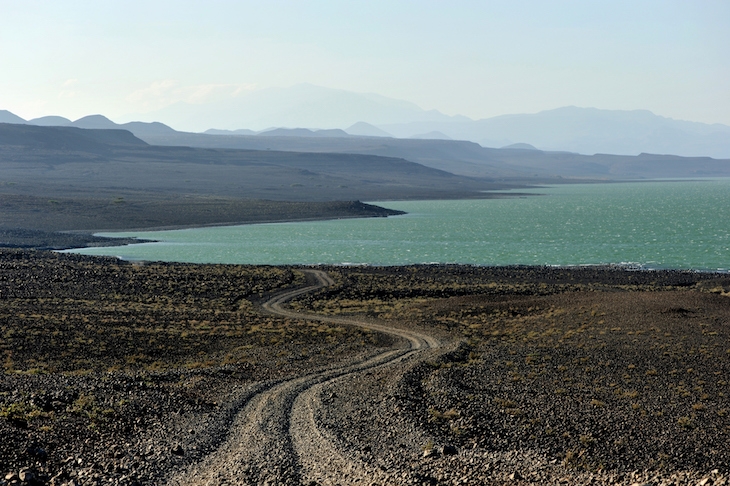As I write, a great gale is blowing in from Lake Turkana. The dry hills on the other side, always faint, have disappeared. Sheets of warm rain lash our tent, rollers crash on to the white sandy shore, huge pelicans struggle against the wind, the flamingos are gone, and fishermen like thin black sticks — Lowryesque — from the Turkana tribe can be seen streaking up the beach ferrying equipment from their now-beached wooden fishing canoe to a clump of doum palms where they’ll shelter.
But nobody is cold. The lake feels like a tepid bath when we swim (where humans fish, the Nile crocodiles stay away), while the air temperature has plummeted within hours from about 45˚C (113˚F) to more like a muggy English summer. These windstorms (though not the rain) are common on Lake Turkana. In this part of far-northern Kenya the average annual rainfall is 110mm (less than five inches), but the region’s oven-like heat meets the sharp cooling effect of this huge body of water to produce great blasts of wind. Readers of my generation will remember this lake from geography lessons as Lake Rudolph: the largest permanent desert lake on the planet, some 150 miles long, 20 to 30 miles wide, and the northern-most of the string of great African lakes along the thousand-mile trench of the Great Rift Valley.
And by far the most remote. Two super-rich Americans arrived by helicopter last night; we got here by flying from Nairobi to the airstrip at Lodwar, then bouncing down to the lake along a sandy track past the tiny, beautiful wicker huts of the Turkana people: about two hours in a hardy Toyota Land Cruiser painted in the milky green that gives the lake its other name, the Jade Sea. You could drive up from Nairobi past Mount Kenya but you’d need two days; and a driver trying to reach Nairobi has just returned, reporting impassable conditions. The dreadful road down from Ethiopia would take longer. From Somalia is too dangerous.
There are no hotels in the European sense. Our lakeshore resort, Lobolo Camp, is really a tented lodge, shockingly comfortable, an oasis of good food, whiskies-and-sodas and friendly service, but the only place of its kind. They sent the Land Cruiser for us, and the whisky.
I’ve always wanted to come here. I thirst for desolate places and natural wonders, and Lake Turkana is both. Why a vast lake in a bone-dry desert? There remains uncertainty. Turkana is fed overwhelmingly from one large permanent source, the Omo river flowing down from the Ethiopian highlands, but there are no visible outflows from the lake. Is evaporation the only leveller? Why, over the millennia, Turkana has not become a giant version of the Dead Sea is a mystery. Though slightly saline, it’s not noticeably brackish: more like fresh water with a pinch of washing soda. I dislike the taste but many Turkana people prefer it.
A second mystery is the level of the lake. This has risen and fallen over the centuries; but a widely expected drop arising from an ambitious (I’d say reckless) new system of dams, hydroelectric plants and irrigation schemes on the Omo river above the border with Ethiopia does not seem to have occurred on any scale. Why not? My own theory is that Lake Turkana is the visible surface of a vastly bigger subterranean sponge, whose aquifers — in or out — remain imperfectly charted or understood.
Crossing is an extraordinary experience. On our second day here we reached the eastern shore after a three-hour, high-speed, outboard-motor-powered ride in a blast of warm spray. The trip was organised by Joyce Chianda-Scheuerman, the African widow of the Dutchman who, with her, created Lobolo Camp. Joyce now runs the lodge with warmth, discipline and passion. She accompanied us on our crossing, organising a second boat loaded with ice boxes, meals and beer. The sun had dropped below the green-grey lake horizon and night had fallen as we were guided in to the far shore: a strange lava-strewn semi-desert where the archaeologist Richard Leakey and the Kenyan museums service maintain a small research establishment, Koobi Fora. We slept there among the desert roses — to my mind the most beautiful plant in creation, bright blossoms springing from fat, grey wood.
For nearly 50 years Leakey and his colleagues have been scrabbling and scrutinising the earth and lava-ash strata above the lake shore, sifting for the remains of human and animal populations that once thrived here. Joyce had organised ground transport, and next morning we lurched into a full desert further north along the shore, to a site where we saw the unearthed 1.7 million-year-old skeleton of a mammoth-like elephant; and then a giant fossilised tortoise; and the remains of a now-extinct crocodile. There was not a living soul along this desert shore, just a hot wind, merciless sun and a weird sense of being transported back millions of years.
From Lobolo Camp a day later we were to drive up the western shore to the site where the Kenyan archaeologist on Leakey’s team, Kamoya Kimeu, discovered the near-complete skeleton of a human-like boy (dubbed ‘Turkana Boy’) who by the banks of a dried-up river mouth had died, wounded, some 1.6 million years ago. Man or animal? The best example of our immediate hominim ancestors so far found. That night we watched a dance by Turkana men and women in splendid tribal dress: the leanest, sparest, blackest and most sinewy human beings I have ever seen. I thought their thin limbs, narrow chests, snake-like hips and jet-black glistening bodies a more beautiful example of the human form than any ideal that western art (or western gymnasia) can produce.
Lake Turkana did not disappoint. This was not a sponsored trip — we paid our way and it was hardly cheap: thus uncompromised, I can recommend Lobolo Camp. Go.
But go only if desolation is your thing. Lake Turkana is life at the edge. As I write, I don’t ever want to come home.







Comments